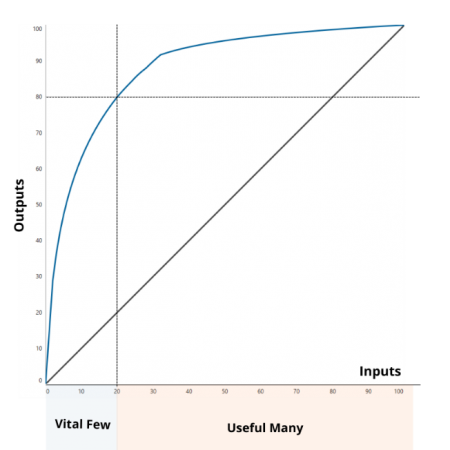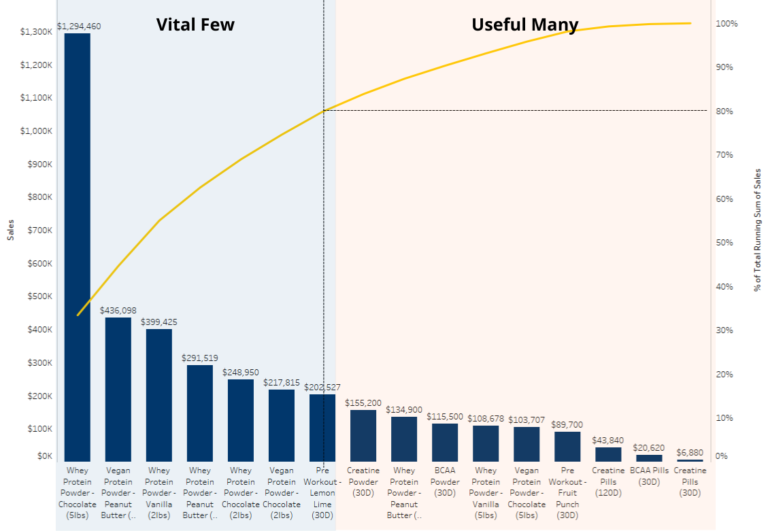The Pareto Principle
Summary
As a business owner, manager, or worker, you have limited time and money to produce results. The Pareto Principle tells you where to spend your limited resources to maximize returns.
What is the Pareto Principle?
The Pareto Principle, referred to as the 80/20 rule, is simple, yet effective. The principle states that 80% of results come from 20% of causes. The principle has broad applications across industries. 20% of products produce 80% of sales in an e-Commerce business. Or, 20% of customers produce 80% of revenue. How does it work?
The economic term, diminishing marginal benefit, is at work behind the principle. If we assume that an additional input results in exactly one additional output, then the output curve would be a 45-degree straight line, like the gray line below. However, we know that isn’t the case because of diminishing return. Adding additional inputs result in less bang for your buck. This results in the blue output curve below.

Say we are spending $200 dollars on marketing a product, and we decide to spend an additional dollar. You have optimized your campaign, so you are getting the most interested customers with the most money with your first $200. The customer that is brought in with the 201st dollar is still interested but may have less money, so they don’t buy as many products as the first customers. The return on the 201st dollar is less, so your return on additional spend diminishes.
Since returns diminish, there are a vital few that produce most of the outputs and a useful many that produce the rest. In the case of the 80/20 rule, 20% of products produce 80% of revenue, or 20% of products result in 80% of returns.
Why should you use the Pareto Principle?
Resources are limited. As a business owner, manager, or worker, you have a limited amount of time and money to produce the best results. The 80/20 rule allows you to focus your limited resources on the vital few that produce the largest impact. In other words, you get the biggest bang for your buck with the vital few compared to focusing on all things.
Here are some use cases:
- An eCommerce business owner can identify the vital few products producing the majority of sales. As the owner, you should focus your time and money on delivering these products seamlessly. You can source complementary products of these vital few to bundle and produce more sales.
- As a return specialist, you can focus on solving the biggest issues first. The 80/20 rule identifies the vital few products resulting in the majority of returns. You should focus on solving issues with these products first.
- As a marketer, you can identify the vital few customers that produce the majority of sales. You can take the characteristics of these customers to build a marketing audience.
How do you apply the Pareto Principle?
The trick to applying the principle is to identify the vital few that are returning most of the outputs. Sort your inputs by their resulting output like the chart below. We have products organized by total sales from the biggest seller on the left to the smallest seller on the right. Then, you calculate the percent of total outputs that each input contributes. Add up the percentages cumulatively. In the example below, Chocolate Whey Protein Powder produces 33% of sales and the Peanut Butter Vegan Protein produces 12% of sales. The yellow line represents the cumulative total of those percentages, meaning both products contribute 45% of total sales. Draw a line from 80% of the cumulative total and the inputs that are before the intersection are your vital few. All products in the list prior to the Lemon Lime Pre-Workout contribute to 80% of the sales. Conversely the nine products on the right-hand side contribute to only 20% of total sales.

It is important to note that implementation of the rule need not be strict. The 80/20 rule is more like a guideline. Maybe 15% of products produce 80% of sales, or maybe we only care about 60% of sales. The point here is to recognize where to spend your limited time and money to return the most results.
How do you do it in Tableau?
There are multiple ways to automate your pareto analyses in Tableau to deliver quick and credible insights. Check out a few ways that we visualized the pareto analysis in Tableau.
We use principles like the pareto analysis to save our clients more than 5x project costs.